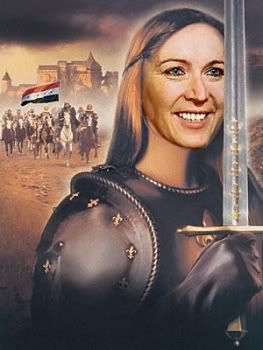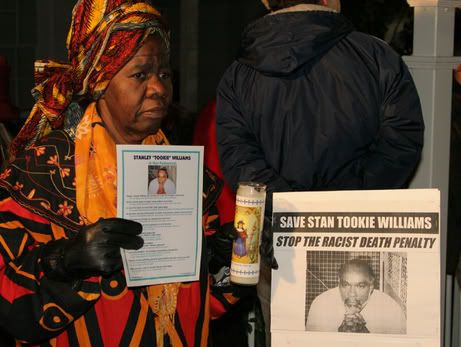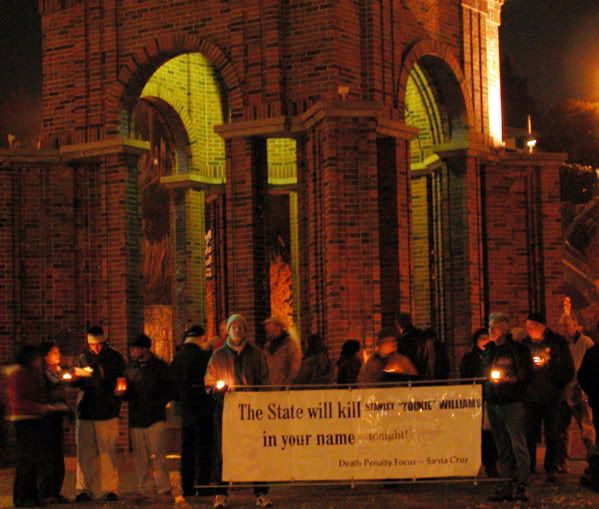I got
the following comment in reply to my post
"A Matter of Solidarity", with the Danish newspaper
Jyllands-Posten , that was:
said…
Thanks for posting the cartoons. The Danish newspaper which published the original cartoons has been forced to apologize. The Brussels Journal blog which has led the reporting of this attack on free speech is now receiving threats. Given the state of free speech in Europe as evidenced by the Italian "prove Christ existed" case, I expect Brussels Journal to be forced to remove the cartoons and their reporting. To guard against that possibility, I have reposted the cartoons and the Brussels Journal reporting thread on my blog. I urge all bloggers who care about free speech to do the same. See Farenheit 451 Alert
Which I herewith do!
_______________________________________
European Appeasement Reinforces Muslim ExtremismFrom the desk of Paul Belien on Tue, 2006-01-24 12:40The Brussels Journal has reported on the developments in the Danish cartoon case since it started in October 2005. We are one of the few non-Danish European observers to do so. Last Sunday, instead of linking to a website with the twelve Danish Muhammad cartoons we decided to add them to
our article about the case. In a sense we were republishing the cartoons, but as we are only a non-commercial website with some 5,000 visitors a day, have no paper edition and did not make a great fuss about publishing them we only received two “threats.” One e-mail, from a certain “Hayet” said.
hello;Les vrais trait de visage de notre profet (que seul les musulmans) lesconnais sont d’un homme le plus beau de monde donc votre photo estratéThe real trace face of our profet mohamed are the best; he is thebest beautiful men in the word. Your photo is misfire
The other, from a certain “Siham,” said:
good morningyou must take us a lot of excuses We respect your profect and all profects; and you you must respect our profect for not to have in futur other problems between us
Both emails were sent via the same IP address in France, indicating that “Hayet” is probably “Siham.”
The best way to end the whole cartoon affair would be for as many websites, blogs and papers in Europe just to publish the cartoons in an act of defiance to extremists. Moderate Muslims take no offense at the cartoons,
as could be seen last week in Denmark where the refusal of the government to give in to demands for press censorship has encouraged the moderates to speak out against the radicals. As Glenn Reynolds
wrote in a comment on the affair: “I think that moderate Muslims are a lot more likely to speak out if they feel confident that the government will stand up to the immoderate ones.” This is an appeal to all of us, not just our governments: If we all stand up to the extremist Muslims the moderate ones will be encouraged to speak out.
We
have been critical (and still are) of the Dutch Somali-born politician Ayaan Hirsi Ali on account of her
opposition to religion and
religious people but Ms Hirsi Ali had a point yesterday when she said that the only way to confront the radicals is a free and open debate. Sadly, she says, there is no free and open debate “because of the complacency and self-censorship of Europe’s political and intellectual elites, the self-pity of the Muslims, and the threat of violence by the jihadists.” Indeed, it is the appeasement attitude and behaviour of the Europeans that is strenghtening the power of the extremists over the moderate Muslims.
Hirsi Ali was speaking in The Hague where she received the “
European of the Year Award” from our American friend (and former inhabitant of Brussels) Conrad Kiechel, the editor of the international editions of Readers’ Digest. The European commissioner Neelie Croes said in her speech that Hirsi Ali is sometimes criticised because of her confrontational approach. “If you believe in eternal life you can afford to be sophisticated. If you do not, you need rebels on this earth to bring about change. Ayaan is a rebel.” In our opinion the Danish Prime Minister Anders Fogh Rasmussen would have been a better candidate for the European of the Year Award. He is not a rebel but a man of principles. Europe does not need rebellion to change things; all it needs is to stand by its principles in order to safeguard its civilization.
One of our readers
drew our attention to the wise commentary of
Mona Eltahawy, a journalist of
Egyptian Muslim origin, in
today’s Daily Star. Unlike Ms Hirsi Ali, Ms Eltahawy has not turned against religion as the root of all evil, but practices a liberal Islam by speaking out against the militancy and terrorism committed in the name of her religion.
She writes about the cartoon case:
Can we finally admit that Muslims have blown out of all proportion their outrage over 12 cartoons depicting the Prophet Mohammad published in a Danish newspaper last September? [...] The initial printing of the cartoons in Denmark led to death threats being issued against the artists, demonstrations in Kashmir, and condemnation from 11 countries. What did any of this achieve but prove the original point of the newspaper’s culture editor, that artists in Europe were censoring themselves because they feared Muslim reaction? [...]
Danish Prime Minister Anders Fogh Rasmussen was right not to intervene, insisting the government has no say over media – the argument used by Arab leaders when they are asked about anti-Semitism in their media, by the way. [...]
What should have remained a local issue turned into a diplomatic uproar that Muslims otherwise rarely provoke when fighting for their rights around the world. Perhaps the Muslim governments who spearheaded the campaign – led by Egypt – felt this was an easy way to burnish their Islamic credentials at a time when domestic Islamists are stronger than they have been in many years.
Must we really boycott Danish products, as one e-mail I received exhorted? [...] Here are a few facts we should remember. However offensive any of the 12 cartoons were, they did not incite violence against Muslims. For an example of incitement, though, one must go back a few weeks before the cartoons were published. In August, the Danish authorities withdrew for three months the broadcasting license of a Copenhagen radio station after it called for the extermination of Muslims. Those were real threats and the government protected Muslims – the same government later condemned for not punishing the newspaper that published the cartoons.
Second, the cartoon incident belongs at the very center of the kind of debate that Muslims must have in the European countries where they live - particularly after the Madrid train bombings of 2003 and the London subway bombings of 2005. While right-wing anti-immigration groups whip up Islamophobia in Denmark, Muslim communities wallow in denial over the increasing role of their own extremists.
As just one example, last August Fadi Abdullatif, the spokesman for the Danish branch of the militant Hizb-ut-Tahrir organization, was charged with calling for the killing of members of the Danish government. [...] Muslims must honestly examine why there is such a huge gap between the way we imagine Islam and our prophet, and the way both are seen by others. Our offended sensibilities must not be limited to the Danish newspaper or the cartoonist, but to those like Fadi Abdullatif whose actions should be regarded as just as offensive to Islam and to our reverence for the prophet. Otherwise, we are all responsible for those Danish cartoons.
We need Muslims like Ms Eltahawy, who speak out against the extremists. We need Western journalists and politicians who support them by not allowing themselves to be intimidated by the extremists. But where are these journalists and politicians? None of his European colleagues has dared to publicly support Mr Rasmussen. On the contrary, both the
European Union and the
Council of Europe (as well as the
United Nations) criticized Denmark over the cartoons. Only a handful of Europe’s papers and magazines has publicly supported a Danish newspaper’s decision to publish the cartoons. Most European mainstream media have not even dared to write about the case, leaving the European public in complete ignorance of a very important international conflict that has been going on for four months now.
More on the Danish cartoon case:Jihad Against Danish Paper, 22 October 2005
Cartoon Case Escalates into International Crisis, 27 October 2005
Out of the Iranian Frying Pan into the Danish Fire, 29 October 2005
Pigs Do Not Fly, 17 November 2005
Bounty Offered for Murdering Cartoonists, 4 December 2005
UN to Investigate Racism of Danish Cartoonists, 7 December 2005
Dispatch from the Eurabian Front, 9 December 2005
Europe Criticises Copenhagen over Cartoons, 21 December 2005
Cartoon Case: EU and UN Call Denmark to Account, 28 December 2005
Danish Cartoon Affair: Letter from a Muslim, 31 December 2005
Danish Muslims Divided over Cartoon Affair, 8 January 2006
Danish Prime Minister Shocked at Lies, 11 January 2006
Scandinavian Update: Israeli Boycott, Muslim Cartoons, 14 January 2006
Denmark: Moderate Muslims Oppose Imams, 19 January 2006
Danish Imams Propose to End Cartoon Case, 22 January 2006












 Knock knock UN...
Knock knock UN...